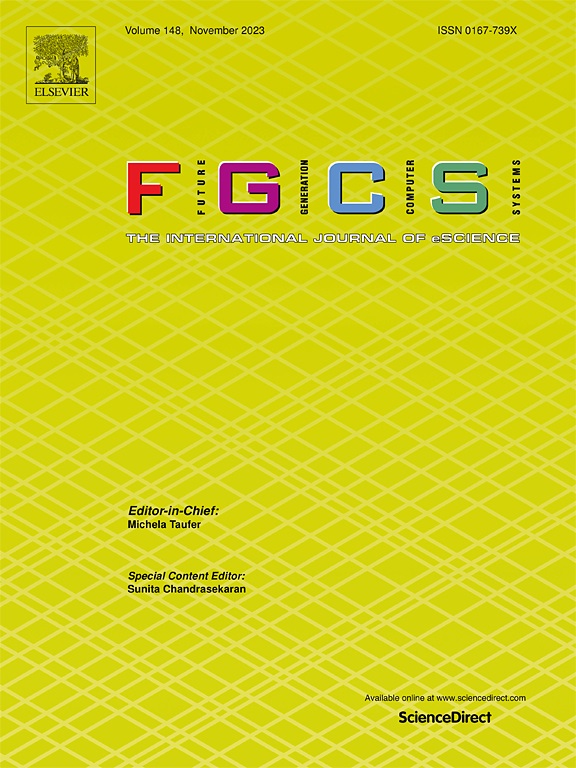QM-ARC: QoS-aware Multi-tier Adaptive Cache Replacement Strategy
IF 6.2
2区 计算机科学
Q1 COMPUTER SCIENCE, THEORY & METHODS
Future Generation Computer Systems-The International Journal of Escience
Pub Date : 2024-10-03
DOI:10.1016/j.future.2024.107548
引用次数: 0
Abstract
Distributed data-centric systems, such as Named Data Networking, utilize in-network caching to reduce application latency by buffering relevant data in high-speed memory. However, the significant increase in data traffic makes expanding memory capacity prohibitively expensive. To address this challenge, integrating technologies like non-volatile memory and high-speed solid-state drives with dynamic random-access memory can form a cost-effective multi-tier cache system. Additionally, most existing caching policies focus on categorizing data based on recency and frequency, overlooking the varying Quality-of-Service (QoS) requirements of applications and customers—a concept supported by Service Level Agreements in various service delivery models, particularly in Cloud computing. One of the most prominent algorithms in caching policy literature is the Adaptive Replacement Cache (ARC), that uses recency and frequency lists but does not account for QoS. In this paper, we propose a QoS-aware Multi-tier Adaptive Replacement Cache (QM-ARC) policy. QM-ARC extends ARC by incorporating QoS-based priorities between data applications and customers using a penalty concept borrowed from service-level management practices. QM-ARC is generic, applicable to any number of cache tiers, and can accommodate various penalty functions. Furthermore, we introduce a complementary feature for QM-ARC that employs Q-learning to dynamically adjust the sizes of the two ARC lists. Our solution, evaluated using both synthetic and real-world traces, demonstrates significant improvements in QoS compared to state-of-the-art methods by better considering priority levels. Results show that QM-ARC reduces penalties by up to 45% and increases the hit rate for high priority data by up to 84%, without negatively impacting the overall hit rate, which also increases by up to 61%.
QM-ARC:QoS 感知多层自适应缓存替换策略
以数据为中心的分布式系统(如命名数据网络)利用网络内缓存,通过在高速内存中缓冲相关数据来减少应用延迟。然而,数据流量的大幅增加使得扩大内存容量的成本过高。为了应对这一挑战,将非易失性内存和高速固态硬盘等技术与动态随机存取内存整合在一起,可以形成一个经济高效的多层缓存系统。此外,现有的大多数高速缓存策略都侧重于根据频繁程度和频率对数据进行分类,忽略了应用程序和客户对服务质量(QoS)的不同要求--在各种服务交付模式中,特别是在云计算中,服务水平协议支持这一概念。缓存策略文献中最著名的算法之一是自适应替换缓存(ARC),该算法使用周期和频率列表,但不考虑服务质量。在本文中,我们提出了一种服务质量感知多层自适应替换缓存(QM-ARC)策略。QM-ARC 扩展了 ARC,利用从服务级管理实践中借鉴的惩罚概念,在数据应用和客户之间纳入了基于 QoS 的优先级。QM-ARC 具有通用性,适用于任意数量的缓存层,并能适应各种惩罚函数。此外,我们还为 QM-ARC 引入了一项补充功能,即利用 Q-learning 来动态调整两个 ARC 列表的大小。我们的解决方案使用合成和实际跟踪进行评估,与最先进的方法相比,通过更好地考虑优先级,在 QoS 方面取得了显著改善。结果表明,QM-ARC 减少了高达 45% 的惩罚,并将高优先级数据的命中率提高了高达 84%,而不会对总体命中率产生负面影响,总体命中率也提高了高达 61%。
本文章由计算机程序翻译,如有差异,请以英文原文为准。
求助全文
约1分钟内获得全文
求助全文
来源期刊
CiteScore
19.90
自引率
2.70%
发文量
376
审稿时长
10.6 months
期刊介绍:
Computing infrastructures and systems are constantly evolving, resulting in increasingly complex and collaborative scientific applications. To cope with these advancements, there is a growing need for collaborative tools that can effectively map, control, and execute these applications.
Furthermore, with the explosion of Big Data, there is a requirement for innovative methods and infrastructures to collect, analyze, and derive meaningful insights from the vast amount of data generated. This necessitates the integration of computational and storage capabilities, databases, sensors, and human collaboration.
Future Generation Computer Systems aims to pioneer advancements in distributed systems, collaborative environments, high-performance computing, and Big Data analytics. It strives to stay at the forefront of developments in grids, clouds, and the Internet of Things (IoT) to effectively address the challenges posed by these wide-area, fully distributed sensing and computing systems.

 求助内容:
求助内容: 应助结果提醒方式:
应助结果提醒方式:


